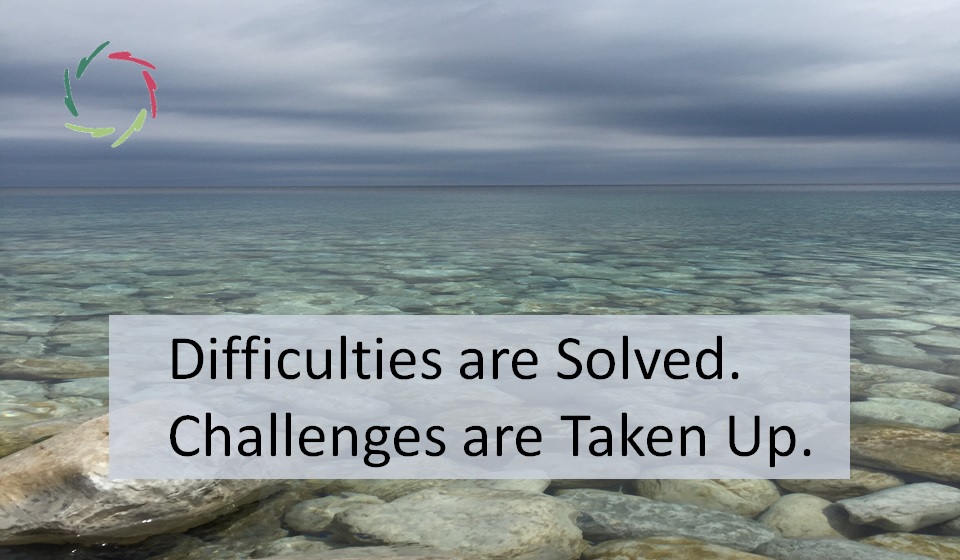Difficulties are Solved. Challenges are Taken Up.

One stumbles over a difficulty. One jumps over a challenge.
The difference between difficulty and challenge is larger than simply a new name for more or less the same.
E.g. a white sheet of paper for the writer of this text or for a business plan: difficulty or challenge…? Difficulties cross your path, initializing the action. You react. Not so with challenges. You initialize the challenge. Even if a ‘difficulty’ is heading for you. You can stay fixed on getting rid of difficulties. Or you can see challenges. Roll up your sleeves!
In essence it is all about openness.
A difficulty is rather like a stone one stumbles over because one doesn’t see it or even doesn’t want to see it before it’s too late. An open vision enables you to see challenges. If necessary one can even take a run-up. With a narrow vision, difficulties lead to defensive reactions and even less openness. Challenges lead to larger openness. In both there is a vicious spiral that is best taken into account. The difference results in a completely different approach. Obvious where the biggest efficiency is found. It also leads to a different inner experience. In short:
Difficulties create stress. Challenges reduce (negative) stress.
This can be extrapolated to burn-out versus flow also known as the happy feeling at the job. Enough up-to-date?
Not solving problems rather leads to feelings of guilt. Challenges have more to do with responsibility.
The feeling of guilt immobilizes; responsibility mobilizes. ‘Guilt’ looks at the past, responsibility repeatedly at the future. What health is concerned: chronic feelings of guilt lead to disease, a feeling of responsibility leads to ‘business-healthy co-workers’…
After the previous, you can of course still talk about ‘difficulties’ if you mean ‘challenges’ from now on. As long as your listeners feel that you think ‘challenges’, it’s okay. But if you think ‘difficulties’ (whatever you call them), you will probably be confronted with an ever-growing craving for control from outside (a pile of administration included), attempts to (make) people change… who in fact do not want to change. Likely especially so in order to thwart you? In short: all the hardships of a boss.
Think ‘challenges’ and you will get energetic employees who like to work together under your Open Leadership.
From this perspective, every performance interview is the chance of a lifetime. It’s interesting not to think about difficulties or challenges at the beginning of the interview. You try to look at the facts together, with the same look. From a psychological angle you are not sitting opposite, but next to each other. Only then, when possible, do you try to look at challenges together. This is a powerful element: doing it together. What the other one is concerned, it comes completely from him or her… and it also comes completely from you. There are no from-beforehand-differing viewpoints. No energy is poured in defence, let alone in whether or not hidden attack. Not only important during the interview, but also for the following days, weeks, months. Challenges are created together and you are constantly in a positive way inside this employee’s mind. This is not manipulation because what you do, you do at the moment itself, totally from within yourself. What concerns you, there are no ‘difficulties’. You don’t emanate them. If people watch you, they will forget them too.
Merely being with you reduces the stress.
There is no fear of having said or done something wrong. People like to come and talk with you, also about possible challenges. This way you keep a finger on the pulse.
Sometimes fear is considered a good source of energy, which enhances the working achievements. So: the more ‘difficulties’, the more energy? Actually, this energy is present before the fear. It only shows itself as fear (aka: ‘negative stress’) if it cannot be realized as something else, e.g. ‘deep motivation’.
Fear does not create motivation-energy.
It canalizes. This canalization as such also requires energy, from your co-workers as well as from you. Moreover: a canal is only so-and-so narrow. How much energy is not reached in this way? Not to mention the possible jams of the canal, floods and what not. It’s better to forget the canal as much as possible. The challenge at the source is so much more interesting!


